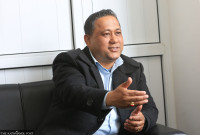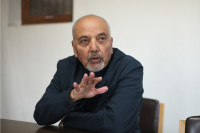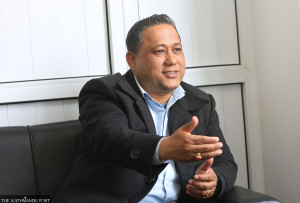Interviews
Gokarna Bista: Foreign employment is not our main agenda, job creation inside the country is
Bista faces a herculean task of creating new jobs and reversing an exodus of migrant workers within the next five years.
Chandan Kumar Mandal
A herculean task of creating new jobs and reversing an exodus of migrant workers confronts the incumbent Minister of Labour, Employment and Social Security, Gokarna Bista, who since his appointment has promised that not a single Nepali will have to take up foreign employment due to lack of jobs in the country within the next five years. But the ministry under his leadership has been pursuing new labour destination countries instead, and signing new agreements or reviewing existing pacts.
The Post’s Chandan Kumar Mandal spoke with Bista to talk about policies to create new jobs, how he would manage the foreign employment sector, his plans to ultimately stop compulsion-driven labour migration, the government’s initiatives so far and the controversies surrounding them, including the much-touted Prime Minister Employment Programme, which has drawn mixed reactions.
This interview has been condensed for clarity.
How do you evaluate the performance of your ministry?
The primary responsibility of the Labour Ministry is to create jobs, draft labour-friendly policies and programmes, promote a safe working environment, ensure workplace safety and effectively implement all labour laws, among others. Besides, we also have to manage foreign employment—an area long marred by mismanagement and fraud. The ministry has been able to draw attention to these long-ignored employment issues and has succeeded in bringing the employment sector to the fore, and given it the significance it deserves. These efforts are not enough, but the ministry is working on, and undertaking, various actions as compared to the past.
A new agreement allows Nepalis to work in Malaysia at zero-cost, but why is it taking so long to implement the deal?
The landmark labour deal is an achievement for the country and our migrant workers. The labour deal is completely workers’ rights friendly. All the expenses—the cost and fees for pre-departure processing and two-way airfare, among others—will be borne by the employer. And as far as the implementation is concerned, we have to fulfil some technical aspects like selecting new health institutions for a health checkup and issuing fitness reports as per the standards set by the Malaysian government. We have completed enlisting such institutions, and the list has been sent to the Malaysian government. It was apparent that the entire process would require some time. There are also rumours that labour departure to Malaysia has been completely stopped but some 60,000 Nepali workers have left for Malaysia since our crackdown on illegal syndicates.
How do you plan to diversify labour destinations for Nepali migrant workers?
Any upheavals in the international labour market would also affect Nepal as it is a labour source country. So it is imperative that we expand the labour market within the country, create new jobs, and utilise our labour force to increase domestic production and productivity. However, we must work towards diversifying our labour destination countries and find more alternatives for our people, besides the Gulf countries and Malaysia.
It is equally essential to think beyond the traditional practice of labour migration. People are ready to invest a considerable amount of money to take up risky jobs only to make as low as Rs20,000 a month. We are working on finding countries that provide opportunities with more income and minimal risk. The ministry is reaching out to the European market and other potential countries where workers can earn two or three times more in comparison to existing countries if they get better jobs.
What are your short- and long-term plans to retain youth within the country?
If we do not produce skilled labour force as per the demands of the market, they will ultimately remain unemployed. The government is working on conducting a labour market survey because the existing plans and policies are based on the census data. The government is considering a system designed to provide real-time data on employment opportunities and the employed population. The employer could then keep a track on the available labour force, while the unemployed population could look for available jobs. But I reiterate that foreign employment is not our main agenda, job creation inside the country is.
What is the guiding idea behind the Prime Minister Employment Programme (PMEP)?
Every year, some 500,000 labour force enter the Nepali labour market. But job creation has not been able to compliment this burgeoning labour force. What’s more, the private sector is helping create most of the jobs. The state can create an investment-friendly environment for addressing the unemployment issues through its plans and policies. But if the market alone cannot create jobs, the government should intervene to ensure income opportunities. Nepal is not the first country to do so. But since we are introducing the employment programme, there have been debates around it, which is both obvious and necessary.
The state has to provide jobs to those who cannot take up foreign employment, or migrate to other parts of the country for livelihood opportunities. People who do not have ancestral property to start self-employment enterprises and those who lack the skill set for the market should also be encompassed by the state.
Our Employment Act also ensures that the state guarantees a minimum 100-days of work to the citizens. If the government fails to do so, the citizens who are below the poverty line, unable to take up foreign employment or are members of a family that has unemployed members will get such allowance. The idea is not merely to distribute money to the unemployed but to help them find jobs.
We should either provide them with the promised days’ work or offer them an allowance which amounts to half of the 100-days of paid work. If there are 600,000 families to whom the government should ensure jobs, failing to do so would mean we would have to distribute 30-35 billions of rupees in allowance and it would create a problematic condition. If we distribute money, it can also give rise to an attitude of doing nothing and staying unproductive at home. And this is something our economy cannot sustain. The PMEP has at least connected unemployed youth with work. It has inspired a culture that one should work and also provided them with social security through work.
But hasn’t PMEP drawn severe criticism since its launch?
Some quarters are critical of this programme because they think the PMEP, which can offer employment opportunities to tens of thousands of youths, could reap political benefits in the future. But the government’s aim is not to gain political mileage through the PMEP. We are just ensuring poor and unemployed people get a job under the social security scheme. It doesn’t recognise any political party cadres, but only citizens who are looking for work. The government will ensure that not a single citizen is discriminated by the state.
Similar criticism was observed when then UML-led nine-month government had launched the old-age pension programme. Now the old-age allowance has become a central and popular policy embraced by all political parties. The PMEP is facing criticism, but we will implement it in a manner that an ordinary Nepali youth will be proud of in the future and feel protected. Ultimately, it will inspire people to take up work and increase productivity.
There are also reports that the government is taking a loan from the World Bank to implement this scheme. How justified is this?
The country has the Foreign Aid Policy to receive international support. The policy itself says that financial assistance can be taken for employment and skill development purposes. Our plan is in line with the policy. For decades, we have been taking loans for educational, health and other sectoral programmes.
Also as far as the loan for PMEP is concerned, there has been some misinterpretation. We will not be withdrawing the money from the bank and distributing it to the public. The funds will be used for skill development instead. It will also connect the labour force with the labour market, and will also generate skilled labour force. The funds will be used for payments to the registered members of the public who have worked in various projects.
***
What do you think?
Dear reader, we’d like to hear from you. We regularly publish letters to the editor on contemporary issues or direct responses to something the Post has recently published. Please send your letters to [email protected] with "Letter to the Editor" in the subject line. Please include your name, location, and a contact address so one of our editors can reach out to you.




 6.1°C Kathmandu
6.1°C Kathmandu













